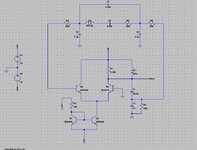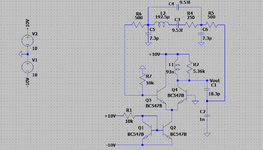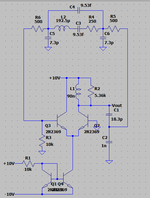saviobezerra
Newbie level 5

First, sorry for my bad english.
I'm building a project using a Colpitts Oscillator with Differential Pair, designed for ~117.6MHz. I'm using LTspice for simulation. The oscillator individually oscillates, but I need it to oscillate when I add a sensor model (as seen in the image in the circuit's feedback loop). When I add the sensor it initially wobbles and then stops, any ideas how I can fix this?
I'm building a project using a Colpitts Oscillator with Differential Pair, designed for ~117.6MHz. I'm using LTspice for simulation. The oscillator individually oscillates, but I need it to oscillate when I add a sensor model (as seen in the image in the circuit's feedback loop). When I add the sensor it initially wobbles and then stops, any ideas how I can fix this?





